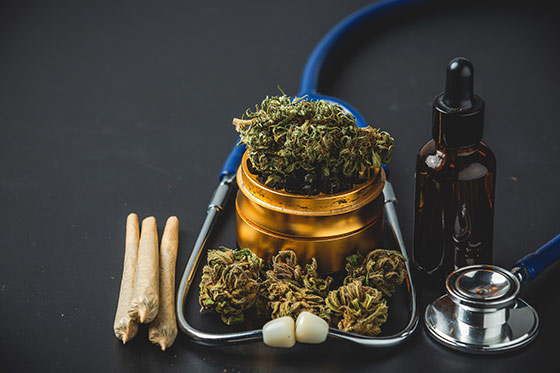The general perception of cannabis, which was once a stigmatized substance, has evolved in recent years. Today, the idea of cannabis for health and wellness has come to gain respect for potential contributions to healthy living.
Cannabis, aka Marijuana, is known for its diverse range of compounds, primarily cannabinoids, that interact with the endocannabinoid system of the human body.
THC (tetrahydrocannabinol) and CBD (cannabidiol) have garnered significant attention over the years. However, the plant contains over 100 known cannabinoids. Each comes with its distinct properties and potential benefits!
Let us explore the multifaceted relationship between cannabis, wellness, and a healthy lifestyle. It has many applications, potential benefits, responsible usage, and broader implications.

Understanding THC: Beyond Recreational Use
THC, or tetrahydrocannabinol, stands as the most widely recognized cannabinoid, primarily due to its psychoactive attributes. It interacts with the receptors in the brain, which alter neurotransmitter release. Tetrahydrocannabinol is what creates the euphoric sensation commonly known as a high. THC and recreation go hand in hand, but its use in cannabis wellness programs is on the rise as well.
The Psychoactive Element
THC from cannabis binds to cannabinoid receptors, notably CB1 receptors in the brain. This interaction triggers a cascade of effects. It influences neural signaling pathways, altering perceptions, mood, and cognitive functions. While these influences can be uplifting, THC also has therapeutic qualities!
Medicinal Potential
While its recreational use is well known, THC does have other applications as well! Research suggests its potential to alleviate symptoms associated with various conditions, including:
- Pain Management: THC interaction with pain receptors offers relief to those with chronic pain. This quality is paving a pathway for alternative pain management therapies.
- Nausea and Appetite Stimulation: THC can have anti-nausea properties. This quality is particularly helpful in managing chemotherapy-induced nausea. It can also stimulate appetite.
- Neurological Disorders: THC can help reduce symptoms in certain neurological conditions. Multiple sclerosis, epilepsy, and Parkinson’s disease are challenging conditions where THC can help.
Balancing Recreational and Medicinal Aspects
Understanding the therapeutic potential of THC requires a shift in perspective. While THC is best known for its recreational use, responsible usage, dosage control, and a balanced approach are essential to harness its therapeutic potential while minimizing its psychoactive impact.

Cannabis Wellness: CBD and Other Cannabinoids
- CBD: In contrast to THC, CBD does not induce intoxication. It interacts with the ECS but does not produce euphoric effects. Therefore, CBD has gained prominence for its potential therapeutic applications, including anti-inflammatory, anxiolytic, and analgesic properties.
- Other Cannabinoids: Lesser-known cannabis cannabinoids like (cannabigerol), CBC (cannabichromene), and THCV (tetrahydrocannabivarin) can also be used in wellness products. They have distinct effects on body receptors, contributing to the entourage effect. In other words, cannabinoids and terpenes work together, enhancing their collective therapeutic potential.
- Antibacterial Properties of CBG: CBG has unusual antibacterial properties. One study found that CBG showed promising activity against methicillin-resistant Staphylococcus aureus (MRSA). MRSA is a form of bacteria known for its resistance to many antibiotics.
Cannabis: CBD for Wellness
Mental Health
Anxiety, depression, and PTSD are prevalent mental health challenges. CBD has emerged as a therapeutic aid due to its anxiolytic properties. It impacts serotonin receptors in the brain, potentially alleviating symptoms. Research into CBD’s action in the brain indicates its ability to modulate neural responses. These include responses to anxiety and stress, presenting possibilities for targeted therapeutic interventions.

Sleep Aid
Sleep disorders and insomnia affect many individuals. Certain cannabis strains, especially those rich in CBD, have been linked to improved sleep quality and duration by influencing sleep cycles. CBD strains have drawn attention for their potential to influence sleep cycles and address sleep-related concerns. CBD products are thus popular for medicinal uses.
Inflammation and Autoimmune Conditions
CBDs have anti-inflammatory properties. Research tells us they help alleviate inflammatory symptoms associated with various autoimmune disorders. Some of them include inflammations due to Lupus, IBD (Inflammatory Bowel Disease), and even Type-1 Diabetes.
Stress Reduction
For those looking at cannabis products solely for stress relief and relaxation, psychoactive effects need to be minimal. Balanced THC-to-CBD ratios are the answer. Such products have calming properties while reducing the high associated with marijuana use.
Cannabis Terpenes: Aromatics with Health & Wellness Benefits
Terpenes, aromatic compounds found in plants like cannabis, contribute to its distinctive flavors and scents. They also work synergistically with cannabinoids, potentially influencing their effects on the body and mind.
Myrcene: This terpene is prevalent in cannabis and is associated with sedative effects. It aids in relaxation and is present in strains known for their calming properties. Myrcene influences the permeability of cell membranes, facilitating the absorption of cannabinoids into the bloodstream. This characteristic is linked to the entourage effect, potentially enhancing the sedative effects of cannabis.
Limonene: Limonene is known for its citrusy aroma. It exhibits mood-enhancing, stress-relieving, and antidepressant properties. It broadens the scope of compounds present in cannabis, offering avenues for exploring holistic approaches to emotional well-being.
Pinene: As the name suggests, pinene has a pine-like scent. It is known to have anti-inflammatory properties and potential respiratory benefits. Its aromatic nature and potential to reduce inflammation brings up multiple medicinal possibilities.

Linalool: Often found in lavender, linalool has a floral aroma and may possess calming and anti-anxiety effects. Studies suggest that linalool, beyond its aromatic qualities, might influence physiological responses. Its purported calming effects could aid in reducing stress and anxiety levels, potentially acting as a natural relaxant. This attribute has led to increased interest in utilizing linalool-rich cannabis strains for their potential to promote relaxation and emotional well-being.
Potential Wellness Contributions of Cannabinoids and Terpenes
The human body houses an intricate endocannabinoid system (ECS), vital to maintaining balance or homeostasis. This system regulates various bodily functions, influencing mood, pain perception, appetite, and immune responses. The ECS has endocannabinoid receptors, naturally occurring in the body. They are similar to external cannabinoids like those found in cannabis. When external cannabinoids enter the body, they affect the ECS.

An entourage effect arises from the synergy between cannabinoids and terpenes. A combined action of these compounds could yield enhanced therapeutic benefits compared to isolated components. For instance, a CBD-rich strain with specific terpenes might offer better stress relief or pain management compared to CBD alone.
Current research focuses on the specific roles of individual cannabinoids and terpenes in targeting various health conditions. These include chronic pain, anxiety, inflammation, and sleep disorders. Understanding these compounds and their synergistic effects could lead to more targeted and effective cannabis-based wellness treatments.
Cannabis as a Potential Pain Management Tool
Chronic pain, a widespread and debilitating condition, affects millions globally and often proves challenging to manage effectively. It can stem from various sources such as injury, nerve damage, or underlying health conditions, significantly impacting quality of life.
The ECS is a complex network of receptors and endocannabinoids that help regulate pain. As we have seen, THC and CBD interact with the ECS, which makes them perfect pain managers. Cannabis for wellness is catching on quickly!
Pain & Perception
THC, in particular, interacts with cannabinoid receptors (CB1 and CB2) in the brain and nervous system. By binding to these receptors, regulated doses of cannabis-extracted cannabinoids can modulate the transmission of pain signals. This binding alters how individuals perceive and process pain sensations, giving them a feeling of wellness.
Reducing Inflammation
Inflammation often accompanies conditions causing chronic pain. Cannabinoids have shown anti-inflammatory properties by interacting with receptors in the immune system. They reduce inflammatory responses that contribute to pain.

Research and Further Studies for Pain Reduction
Several studies have explored cannabis and cannabinoid efficacy in managing chronic pain conditions:
Neuropathic Pain: Neuropathic pain, resulting from nerve damage, has been a focal point in research. Cannabis-derived compounds, particularly cannabinoids like CBD and THC, interact with the receptors in the brain and nervous system. This reaction modulates pain pathways, offering relief from neuropathic symptoms.

Arthritis: Conditions like rheumatoid arthritis can cause inflammation and joint pain. Cannabis-derived compounds, especially CBD, can help reduce inflammatory pain associated with conditions like RA. CBD is known for its ability to modulate inflammatory responses.
Cancer-Related Pain: Patients undergoing cancer treatment experience severe pain. Cannabis-based medications aid in managing such pain. Cannabis-based therapies might reduce opioid use to manage pain and improve overall quality of life.
Integrating Cannabis into a Healthy Lifestyle
Mindful Consumption: Responsible cannabis use involves understanding individual tolerances, strain compositions, and suitable dosages. Different strains and products yield distinct effects, requiring users to tailor their consumption accordingly. An understanding of your tolerance to cannabis is crucial. Prior experience, frequency of use, and individual body chemistry influence how someone responds to cannabinoids. Beginning with low doses and gradually increasing them can help gauge personal tolerance.
Consultation with Healthcare Providers: Cannabis may interact with certain medications, impacting their effectiveness or causing adverse reactions. Healthcare professionals can provide insights into potential drug interactions. It is advisable to do so, ensuring safe usage while enjoying the benefits of cannabis products.
Varied Consumption Methods: There are many methods of cannabis consumption, each with its onset times and durations. Smoking, vaping, edibles, oils, and topicals each cater to individual preferences and needs.
The array of cannabis consumption methods provides users with options to tailor their cannabis experience based on desired personal preferences. As an example, smoking and vaping could induce almost immediate results. Edible products usually take more time as they go through the digestive process.

Balanced Lifestyles: Cannabis should ideally be a supplement, not a replacement, to established healthy habits. It should accompany exercise, nutrition, and stress management. A balanced lifestyle also avoids the possibility of cannabis dependency.
Legal and Social Considerations
Despite shifting attitudes, legal status and social acceptance of cannabis differ significantly worldwide. Knowledge of regional laws, workplace policies, and societal norms is essential to use cannabis responsibly.
At the federal level, cannabis remains a Schedule I controlled substance. However, federal enforcement has relaxed in states with legalized cannabis, allowing states to implement their regulations.
Legalization Trends: Several US states have legalized cannabis for both medical and recreational use. Specifics of legality, possession limits, and cultivation regulations differ across states.
Medical Cannabis Programs: Many states have established medical cannabis programs, which allow people access to cannabis for therapeutic purposes with a medical prescription.
Recreational Use: Some states permit recreational cannabis use for adults, enabling legal purchase and consumption through licensed dispensaries.
Conclusion
The potential of cannabis to contribute to wellness continues to spark interest and research, and its integration into a healthy lifestyle requires thoughtful consideration. Responsible usage and compliance with local legal and societal frameworks are the key. Perceptions of cannabis use are experiencing an evolutionary phase.
Navigating the legal and social landscape of cannabis in the USA involves understanding state-specific laws. The use of marijuana in different regions of the world requires a specific study of the laws of those countries!
From what we can tell, the idea of cannabis wellness is here to stay!
The information provided is not a substitute for professional medical advice, diagnosis, or treatment. Consult with a qualified healthcare professional for personalized advice based on your medical condition.




